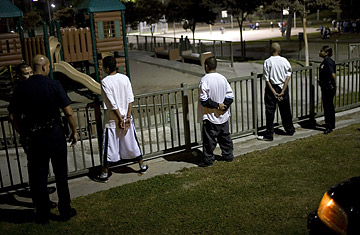
Los Angeles Police Department gang unit officers question and search confirmed MS-13 street gang members in the Rampart area of Los Angeles, California.
(2 of 2)
As Beaver's study shows, not all carriers of the defective MAO-A gene join a gang, and not all gang members have the defect. It remains largely unknown how common the low-active gene variant is in the general population, though one 2002 study indicated that genetic factors, including MAO-A, account for as much as 50% of the population variance in risk for antisocial behaviors. Additionally, Beaver's and other studies have found that low levels of the MAO-A enzyme affect only men, despite the fact that the MAO-A gene is located on the X chromosome. One explanation is that male-specific hormones may play a role in MAO-A expression, or that females may have other biological traits that mitigate the effect of a defect, or simply that females have two copies of MAO-A versus males' one.
"Males, who have one X chromosome and one Y chromosome, possess only one copy of this gene, while females, who have two X chromosomes, carry two," Beaver says. "Thus, if a male has a variant for the MAO-A gene that is linked to violence, there isn't another copy to counteract it." (See the top 10 scientific discoveries of 2008.)
Any compensation would have to come from the environment, and studies suggest that early intervention can have great impact. Researchers at the University of Georgia last month published a study of 641 adolescents, ages 11 to 16, some of whom carried the short allele form of the gene 5-HTTLPR — a genetic condition found in about 40% of the general population and long associated with low self-control, binge drinking and substance use. Half of the participants were randomly enrolled in drug prevention programs. After five years, those participants with 5-HTTLPR who were enrolled in a prevention program were no more likely than their counterparts in the comparison group, without the gene, to have engaged in drinking, smoking marijuana, and sexual activity. Youths with the gene, who were in the comparison group, were twice as likely to have engaged in these risky behaviors as their peers in the prevention group.
"The findings underscore that 'nurture' can influence 'nature' during adolescence, a pivotal time when delaying the start of alcohol consumption and other risky behaviors can have a significant impact on healthy child development," said Kenneth R. Warren, acting director of the National Institute on Alcohol Abuse and Alcoholism, in a statement.
Beaver cites last month's prevention study as key to understanding how to best make use of his latest findings on MAO-A and gang membership. If policymakers wish to prevent violence, he says, money would be better spent not hunting for gene-based drugs, say, but expanding and improving neighborhood-based intervention programs, such as early childhood education and after-school activities.
"It's much easier and cost-effective to modulate an individual's environment than it is to alter their genetic code," says Buckholtz. And until the gene is better understood, that investment will pay off for those with the MAO-A defect and those without.
